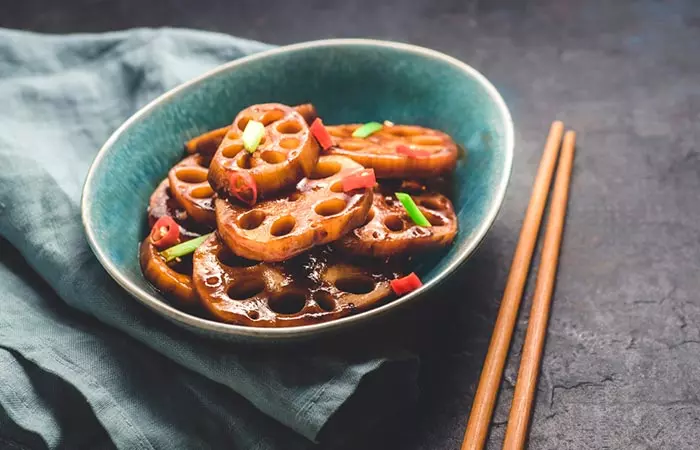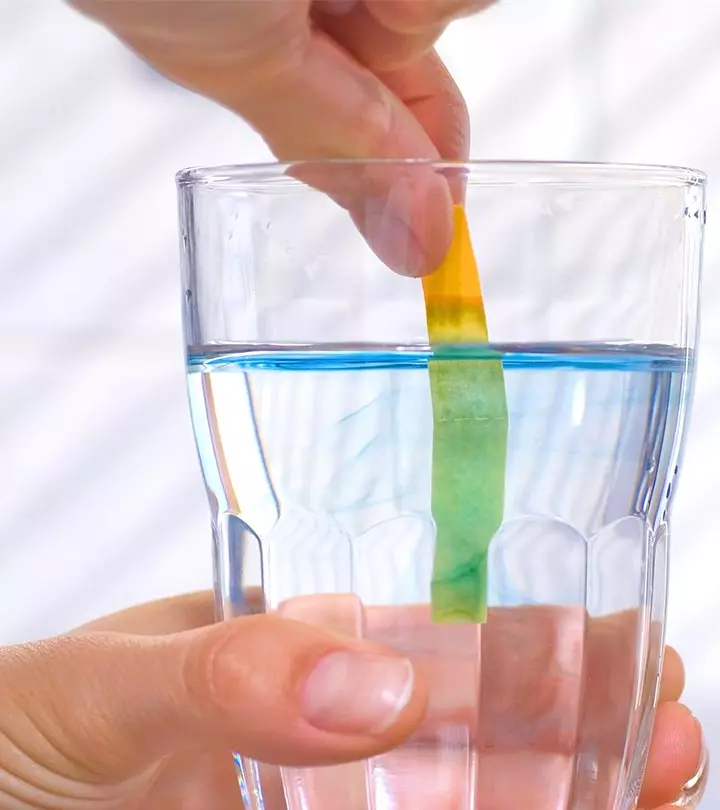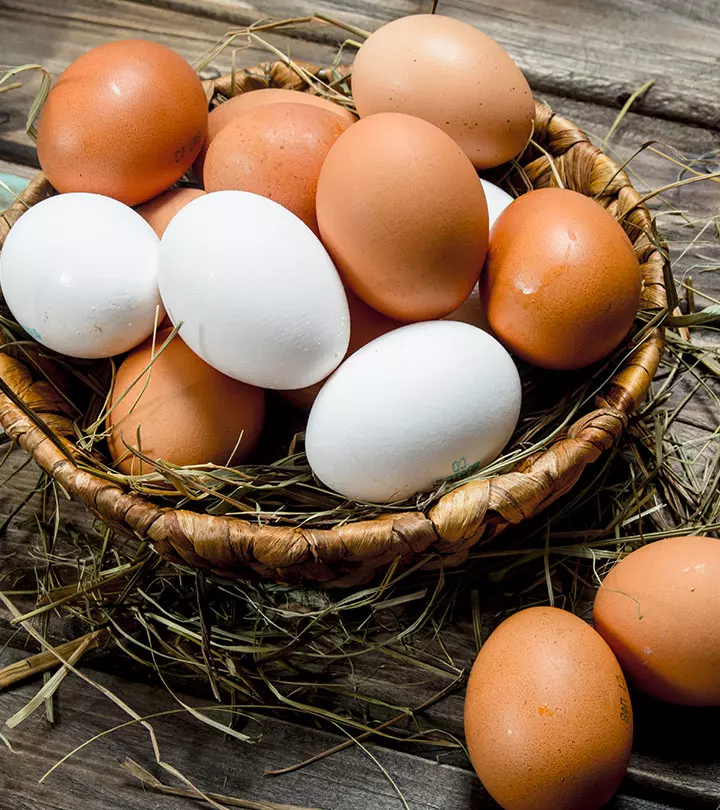9 Amazing Lotus Root Health Benefits You Need To Know
They are savory and are also known for their amazing therapeutic properties.

Image: Shutterstock
The lotus root is a vegetable root with therapeutic benefits. It has been used in Asian traditional medicine for centuries. Lotus root benefits your health in a number of ways, thanks to its rich nutrition profile. It is a great source of carbohydrates, fiber, and antioxidants that help treat many ailments.
This nutritional food source is used to add seasoning to foods and has several culinary applications too. This article explores the nutritional breakdown of lotus root, its health benefits, how to include it in your diet, and its possible side effects. Keep reading.
 Know Your Ingredient: Lotus Root
Know Your Ingredient: Lotus RootWhat Is It?
The edible root of the lotus plant that has a crunchy texture.
What Are Its Benefits?
It may help protect the liver, reduce inflammation, help manage diabetes and treat allergies.
Who Can Use It?
People who have fatty liver disease, digestive issues, and stomach ulcers.
How Often?
2–3 times a week, or as recommended by your doctor.
Caution
Those with kidney disease may need to restrict their consumption of foods high in potassium, such as lotus root.
In This Article
What Is Lotus Root?
Lotus (Nelumbo nucifera Gaertn.) belongs to the aquatic flowering plants family Nelumbonaceae. It is widely cultivated in China, Korea, Japan, and India as an ornamental plant for food and medicinal purposes (1). Lotus roots are its submerged stems. They are cylindrical and segmented (like connected sausages). The tubular roots have air channels running along their lengths, and when you cut them, you will see holes (2).
Elliot Reimers, CISSN, CNC, says, “Lotus root is a plant mostly found in lakes and rivers. There are a number of uses to the lotus root in regards to medicine, and almost the entire plant has different medicinal qualities.”
The roots of its use in traditional medicine could be traced to its nutritional value.
 Fun Fact
Fun FactHe adds, “Lotus root is full of many important minerals, nutrients, and vitamins, and it is also an amazing source of fiber.” Scroll down to check the wide range of nutrients it contains.
Key Takeaways
- Lotus is widely cultivated as an ornamental plant for food and medicinal reasons in China, Korea, Japan, and India.
- Its root has a rich nutritional profile that may protect the liver, reduce the risk of stomach ulcers, and treat allergies.
- The vegetable is used to enhance dishes and has various culinary uses.
- However, make sure you are not allergic to lotus roots before eating them.
Lotus Root Nutritional Information
A hundred grams of cooked lotus root contains (3):
Calories | 86 kcal |
Proteins | 1.54 g |
Carbohydrates | 15.5 g |
Total lipids (Fat) | 2.6 g |
Calcium | 26 mg |
Potassium | 352 mg |
Magnesium | 21 mg |
Sodium | 166 mg |
Phosphorus | 76 mg |
Iron | 0.87 mg |
Reimers adds, “The fiber that comes from the lotus root has been said to help our bodies with the regulation of blood sugar and can also help improve our digestion.” Here are some other reasons to eat lotus root.
Health Benefits Of Lotus Root

1. May Protect The Liver
A mice study found that oral lotus root powder could prevent non-alcoholic fatty liver disease. Researchers found that lotus roots could suppress inflammatory gene expression associated with the condition, increase serum adiponectin levelsi A measurement of adiponectin, a hormone released by the fat tissue that helps regulate insulin in the body and fights inflammation. , and protect the liver (4). Fermented lotus root extract may improve liver detoxification capacity and repair the liver cells damaged due to alcoholism. It may have a therapeutic effect on acute alcoholism issues (5).
2. May Protect Against Stomach Ulcers
A study on rats showed that fermented lotus root could protect the stomach against stomach ulcers.
It has antioxidant and anti-inflammatory properties that add to its gastroprotective effects and speed up the recovery of the mucous layer of the stomach (gastric mucosa) (5).
3. May Reduce Inflammation
Fermented lotus roots contain linoleic acid. This fatty acid can reduce inflammatory responses within the body by regulating the immune system and help prevent acute inflammatory conditions like acute hepatitisi A medical condition in which the liver is inflamed, impeding normal functioning, such as blood filtering and resisting infection. and autoimmune diseasesi Diseases in which the immune system fails to differentiate between foreign and own cells, causing it to damage healthy cells. (6).
4. May Help Manage Diabetes
An animal study found that lotus root extract could significantly reduce blood sugar levels in diabetic and normal rats.
Researchers also observed improved glucose tolerance and insulin action (7). Consuming lotus root extract may have a similar effect in humans. However, more human studies are required to substantiate the effect.
5. May Treat Allergy
A mice study found that lotus root powder could reduce nasal allergy symptoms in mice. It contains vitamin C and other polyphenolic compounds that can reduce serum histamine (a compound released by cells that triggers allergic reactions) levels and other inflammatory parameters (8).
6. May Promote Gut Health
Lotus roots are a good source of dietary fiber. A fiber-rich diet promotes regular bowel movements and increases fecal weight and frequency (9).
7. May Control Weight Gain
Lotus root extract can reduce fat tissue weight (adipocytes) and have anti-obesity effects in human cells. It prevents lipid accumulation in cells and may lower blood cholesterol levels (10). This may also help prevent obesity-related conditions.
8. May Promote Heart Health
Potassium in the roots helps to reduce the bad LDL cholesterol by acting as a great vasodilatori Medications used to dilate blood vessels, which eases the flow of blood and relieves blood pressure. . It also prevents arteries from clogging up and reduces the risk of heart attacks. Pyridoxine in lotus roots helps manage homocysteine levelsi Refers to the level of homocysteine (an essential amino acid) in the body, which indicates vitamin deficiencies. in the blood and protects the heart. High homocysteine levelsi Refers to the level of homocysteine (an essential amino acid) in the body, which indicates vitamin deficiencies. in the blood damage the lining of the arteries.
9. May Help Reduce Stress

Vitamin B complex, especially pyridoxine in the lotus root, interacts with neural receptors of our brain and may help reduce stress, irritability, and headaches.
Reimers says, “Some of the other reasons lotus root is good for you include that it’s not a common food allergen, it has a low water footprint, and it is naturally gluten-free.” Also, it contains vitamin B and C, which are essential for healthy skin and hair. These benefits make it worthwhile to include lotus root in your diet. Here’s how you can do it.
 Trivia
TriviaHow To Add Lotus Root To Your Diet: Popular Recipes

Lotus root is mildly sweet and has a crunchy, starchy texture. As it cooks, it softens without losing its crunch and flavor. The vegetable is versatile – it is crisp when stir-fried and tender and creamy when baked.
You cannot consume raw lotus roots as they increase the chance of bacterial infections; you need to either boil or steam them. Peel off its skin and rinse it thoroughly before boiling for 10 minutes. However, if you want to soften its texture, boil the roots for not more than 20 minutes. Here are a few recipes to try.
1. Lotus Root Stir-Fry
Make your lunchtime a little more exciting with this savory side dish.
What You Need
- 300 g lotus root
- 1 cup of mushrooms (chopped)
- ½ cup of red bell pepper (chopped)
- ¼ cup of chicken stock
- 2 teaspoons of oyster sauce
- ¼ teaspoon of sugar
- 1/8 teaspoon of white pepper
- 2 tablespoons of oil
- 6 slices of ginger
- 2 garlic cloves (minced)
- 2 scallions (chopped)
- 1 tablespoon of dry sherry
- 2 teaspoons of cornstarch
- Salt, as needed
How To Prepare
- Blanch lotus roots, mushrooms, and bell peppers for 45 seconds and set aside.
- Mix the chicken stock, oyster sauce, salt, sugar, and white pepper in a small bowl to make the sauce mixture.
- Sauté ginger, garlic, and scallions for a minute over medium heat.
- Add the blanched vegetables and stir-fry for 1 minute.
- Add dry sherry around the edge of the wok, followed by the sauce mixture.
- Add the cornstarch-water mix and cook for 30 seconds until the sauce is simmering.
- Stir-fry for another 20-30 seconds until the sauce coats the vegetables, and serve.
2. Baked Lotus Root Chips
Replace the potato chips with this tasty snack! Create your flavor by mixing different spices.
What You Need
- 200 g lotus roots
- 1 teaspoon of black pepper (freshly ground)
- ½ tablespoon of salt
- 2 tablespoons of olive oil
How To Prepare
- Preheat the oven to 325°F.
- Mix all the ingredients in a large bowl.
- Drizzle oil and arrange the sliced roots on a baking sheet.
- Bake for 20 minutes or until golden brown.
- Drain on a paper towel. Serve with a dip or add your blend of spices.
3. Pork And Lotus Root Soup

This hearty, flavorful soup will satisfy your soul and hunger.
What You Need
- 500 g lotus root
- 500 g pork ribs
- 100 g peanuts
- 1 carrot (peeled and chopped)
- 1 dried cuttlefish, rinsed (optional)
- 8 dates (dried, deseeded)
- Salt, as needed
How To Prepare
- Soak peanuts in boiling water for 30 minutes.
- Blanch pork ribs for 5 minutes and set aside.
- Slice the lotus roots into bite-sized pieces.
- Add all the ingredients to a soup pot and add water to cover them.
- Boil the soup. Cook it for 2-3 hours on low heat or until the meat is tender.
- Add salt and serve hot.
Krista Goon, a blogger, shared her insight on storing the lotus root soup in her blog. She said, “While I like lotus root soup, it doesn’t freeze well (i).” She added, “I usually make a large pot of soup and freeze the leftover portions in individual containers. If you freeze lotus root, its texture crumbles. When you reheat the soup, the soup still tastes great but the lotus root won’t be as lovely to bite into!”
4. Stuffed Lotus Root
Ingredients
- 1 stem of lotus root
- 1 teaspoon of light soy sauce
- ½ cup of minced pork
- 1 tablespoon of whisked egg
- A pinch of salt
- A dash of pepper
- Chopped green onion for garnishing
How To Prepare
- Cut the lotus root into slices and soak the slices in clean water. Be careful while cutting the root as it can break easily.
- Marinate the minced pork with salt, light soy sauce, egg, and pepper to make the filling.
- Place approximately 1 teaspoon of the filling in the center of one lotus root slice, and then cover it with another slice.
- Heat the pan, brush it with oil, and fry all the lotus root slices until they turn slightly golden brown.
- Flip the slices to cook the other side.
- Garnish the dish with some salt, pepper, and chopped green onions before serving.
You can also add lotus root to your salads or blend it with your smoothies for extra crunch and nutrients. It is always best to consume fresh lotus roots. However, you can also store them for later use. Here are a few tips.
Tips To Store Lotus Root
You can refrigerate lotus roots for up to a week. Ensure to store peeled and sliced roots in an airtight container. Sliced lotus roots are prone to browning. You can soak them in vinegar to prevent browning. Discard the roots if they develop black spots or an unpleasant smell.
Lotus roots are delicious and healthy. However, you have to be careful while consuming them.
Side Effects And Allergies

Though it is rare, people can be allergic to lotus roots. There has been a case where a 6-year-old girl experienced allergic reactions after consuming fried lotus roots (11).
Lotus root is high in potassium levels (3). So if you have certain kidney conditions or those on potassium-restricted diets, it is best to consult your doctor before consuming it.
Reimers adds, “Some of the possible side effects of lotus root include bad breath, fever, diarrhea, and problems with the liver. While it is plant-based and has many health benefits, individuals should speak with their doctor before incorporating it into their diet too quickly.”
Infographic: 5 Reasons To Use Lotus Root
Lotus root is commonly used in traditional Asian medicine to treat various ailments. It contains fiber, vitamins, and minerals that help boost liver and heart health and aid in weight loss. Check out the infographic below to discover why this versatile and nutritious vegetable is a valuable addition to your diet.

Illustration: StyleCraze Design Team
Lotus roots can be a great snack to munch on. They have a mildly sweet taste and are crunchy when fried or baked. This popular Asian ingredient is loaded with potent antioxidants, healthy carbs, vitamins, and minerals that support good health. Lotus stem benefits are not just limited to its culinary applications, it also has several potential health benefits. Lotus root health benefits range from protecting the liver to promoting gut function. It may help reduce the harmful free radicals present in your body and reduce inflammation. Lotus root may help manage diabetes and weight loss as well. However, when consumed in excess, it can cause problems. You should limit its use and consult a doctor if any adverse reactions occur.
Frequently Asked Questions
Is lotus root environmentally sustainable?
Yes, lotus root can be environmentally sustainable. It grows in water and uses less land. However, when harvested following sustainable farming practices it has no negative impact on the environment.
Does lotus root make you sleepy?
Yes. As per studies, oral administration of 150 mg/kg of lotus rhizome water extract helps promote sleep (12).
Does lotus raise blood pressure?
No. Anecdotal evidence suggests that the presence of potassium (a vasodilatori Medications used to dilate blood vessels, which eases the flow of blood and relieves blood pressure. ) in lotus roots helps relax blood vessels and reduce their contraction. This, in turn, may lower blood pressure levels. However, limited studies are available in this regard.
Does lotus tea make you poop?
The dietary fiber in lotus tea may bulk up the stool and promote bowel movements. However, more research is warranted in this regard.
Is lotus root keto-friendly?
No. Lotus root is not keto-friendly due to its high carb values. According to the USDA, 100 grams of lotus root contains 15.5 g of carbs (3).
Illustration: Lotus Root: Health Benefits Recipes Side Effects And More

Image: Stable Diffusion/StyleCraze Design Team
Learn about the amazing benefits of lotus root! Watch this video to discover its nutrient facts and how it can help improve your health.
Personal Experience: Source
StyleCraze's articles are interwoven with authentic personal narratives that provide depth and resonance to our content. Below are the sources of the personal accounts referenced in this article.
i. Why It’s Not Good To Freeze Lotus Root Souphttps://soupqueen.blogspot.com/2019/09/why-its-not-good-to-freeze-lotus-root.html
References
Articles on StyleCraze are backed by verified information from peer-reviewed and academic research papers, reputed organizations, research institutions, and medical associations to ensure accuracy and relevance. Read our editorial policy to learn more.
- Phenolic Profiles and Antioxidant Activity of Lotus Root Varieties
https://www.ncbi.nlm.nih.gov/pmc/articles/PMC6273286/ - The Latest Studies on Lotus (Nelumbo nucifera)-an Emerging Horticultural Model Plant
https://www.ncbi.nlm.nih.gov/pmc/articles/PMC6696627/ - Lotus root cooked FoodData Central
https://fdc.nal.usda.gov/fdc-app.html#/food-details/1103520/nutrients - Effects of Lotus Root (the Edible Rhizome of Nelumbo nucifera) on the Deveolopment of Non-Alcoholic Fatty Liver Disease in Obese Diabetic db/db Mice
https://academic.oup.com/bbb/article/76/3/462/5954677?login=true - The mitigative effect of lotus root (Nelumbo nucifera Gaertn) extract on acute alcoholism through activation of alcohol catabolic enzyme, reduction of oxidative stress, and protection of liver function
https://www.ncbi.nlm.nih.gov/pmc/articles/PMC9875029/ - Gastroprotective Effects of Fermented Lotus Root against Ethanol/HCl-Induced Gastric Mucosal Acute Toxicity in Rats
https://www.mdpi.com/2072-6643/12/3/808 - Anti-Inflammatory Effects of Fermented Lotus Root and Linoleic Acid in Lipopolysaccharide-Induced RAW 264.7 Cells
https://www.mdpi.com/2075-1729/10/11/293 - Effect of Nelumbo nucifera rhizome extract on blood sugar level in rats
https://www.sciencedirect.com/science/article/abs/pii/S0378874197001074 - Anti-allergic activity of lotus root (Nelumbo nucifera) powder in TDI-sensitized nasal allergy model mice
https://www.tandfonline.com/doi/full/10.1080/09540105.2019.1651255 - Dietary fiber and digestive health in children
https://academic.oup.com/nutritionreviews/article/75/4/241/3747768?login=true - Ethanol extract of lotus (Nelumbo nucifera) root exhibits an anti-adipogenic effect in human pre-adipocytes and anti-obesity and antioxidant effects in rats fed a high-fat diet
https://www.sciencedirect.com/science/article/abs/pii/S0271531714000165 - Identification of a novel food allergen in lotus root
https://www.researchgate.net/publication/317722192_Identification_of_a_novel_food_allergen_in_lotus_root - Sleep-promoting activity of lotus (Nelumbo nucifera) rhizome water extract via GABAA receptors
https://www.ncbi.nlm.nih.gov/pmc/articles/PMC9291699/https://www.ncbi.nlm.nih.gov/pmc/articles/PMC9291699/https://www.researchgate.net/publication/317722192_Identification_of_a_novel_food_allergen_in_lotus_root
Read full bio of Silky Mahajan
Read full bio of Payal Karnik
Read full bio of Ravi Teja Tadimalla
Read full bio of Moksha Gandhi



























Community Experiences
Join the conversation and become a part of our empowering community! Share your stories, experiences, and insights to connect with other beauty, lifestyle, and health enthusiasts.